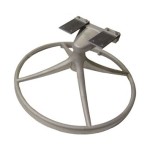Creating a Thriving Herb Garden on Your Patio or Balcony
The allure of fresh, fragrant herbs is undeniable, adding both flavor and aroma to culinary creations. Cultivating an herb garden is an increasingly popular pursuit, and the constraints of limited space are no longer a barrier. A patio or balcony can readily transform into a flourishing herb haven, providing a convenient and aesthetically pleasing source of fresh ingredients. This article explores the essential considerations for establishing and maintaining a successful herb garden in these compact environments.
Selecting the Right Herbs for Your Space
The first step in establishing a patio or balcony herb garden involves judicious plant selection. Not all herbs thrive in confined spaces or tolerate the specific conditions offered by a patio or balcony. Factors such as sunlight exposure, prevailing winds, and temperature fluctuations significantly influence the success of different herb varieties.
Consider herbs that are naturally compact and less prone to aggressive growth. Basil, chives, mint (consider containing due to its invasive nature), parsley, thyme, oregano, rosemary (dwarf varieties), and sage are generally well-suited for container gardening. These herbs tolerate pruning and respond well to the restricted root space of pots and planters.
Sunlight is a crucial determinant. Herbs like basil, rosemary, and thyme require at least six hours of direct sunlight per day. Parsley, mint, and chives can tolerate partial shade, receiving four to six hours of sunlight. Assessing the amount of sunlight your patio or balcony receives throughout the day is imperative for choosing appropriate herbs. Southern-facing patios typically offer the most sunlight, while northern-facing patios may be better suited for shade-tolerant herbs.
Wind exposure can also impact herb selection. Exposed balconies can subject plants to drying winds, which can damage delicate foliage and increase water demand. Herbs with sturdy stems and waxy leaves, such as rosemary and thyme, are better equipped to withstand windy conditions. Providing windbreaks, such as trellises or strategically placed screens, can mitigate the effects of strong winds on more delicate herbs.
Consider the intended use of the herbs. If culinary purposes are paramount, select herbs that align with your favorite recipes. If aromatherapy or medicinal applications are desired, research the specific properties of different herbs and choose those that meet your needs. Grouping herbs with similar watering and light requirements simplifies care and promotes optimal growth.
Ultimately, the best herbs for a patio or balcony garden are those that are well-suited to the environmental conditions, aligned with the gardener's preferences, and manageable within the limited space.
Optimizing Container Selection and Soil Composition
Choosing appropriate containers is critical for the health and productivity of a patio or balcony herb garden. Container size, material, and drainage are all important considerations.
Container size should be proportionate to the mature size of the herb. Smaller herbs, such as thyme and chives, can thrive in relatively small pots, while larger herbs, such as rosemary and basil, require larger containers to accommodate their root systems. As a general guideline, herbs with shallow root systems can be planted in pots that are at least 6 inches deep, while herbs with deeper root systems require pots that are at least 12 inches deep. Insufficient container size can lead to stunted growth and nutrient deficiencies.
Container material influences drainage and heat retention. Terracotta pots are porous, allowing for good airflow and drainage, but they can dry out quickly in hot weather. Plastic pots retain moisture better than terracotta, but they can also become waterlogged if drainage is poor. Glazed ceramic pots offer a balance between moisture retention and drainage. Dark-colored pots absorb more heat than light-colored pots, which can be beneficial in cooler climates but detrimental in hot climates. Ultimately, the best container material depends on the climate and the specific needs of the herbs.
Adequate drainage is essential for preventing root rot and ensuring healthy herb growth. Containers should have drainage holes at the bottom to allow excess water to escape. Placing a layer of gravel or broken pottery at the bottom of the container can improve drainage. Avoid using saucers that allow water to accumulate around the base of the pot, as this can create a breeding ground for pests and diseases.
Soil composition is equally crucial. Garden soil is typically too heavy and compacted for container gardening. A well-draining potting mix is essential for providing adequate aeration and drainage. Commercial potting mixes are usually composed of a blend of peat moss, perlite, and vermiculite. Adding compost to the potting mix improves drainage, nutrient retention, and soil structure. Avoid using potting mixes that contain slow-release fertilizers, as these can lead to excessive growth and reduced flavor in some herbs. Consider using organic potting mixes to avoid synthetic fertilizers and pesticides.
When transplanting herbs into containers, gently loosen the root ball and remove any circling roots. Place the herb in the center of the container and fill in around the root ball with potting mix. Water thoroughly after planting to settle the soil and reduce transplant shock. Mulching the soil surface with organic mulch, such as shredded bark or straw, can help retain moisture, suppress weeds, and regulate soil temperature.
Effective Watering, Fertilizing, and Pruning Techniques
Consistent and appropriate watering is fundamental to the success of a patio or balcony herb garden. Overwatering and underwatering can both lead to plant stress and reduced growth. The watering frequency depends on the herb species, container size, potting mix, and environmental conditions.
As a general rule, herbs should be watered when the top inch of soil feels dry to the touch. Use a watering can or hose with a gentle spray nozzle to water the herbs thoroughly, ensuring that the water penetrates the entire root zone. Avoid watering the foliage, as this can promote fungal diseases. Water early in the morning to allow the foliage to dry before nightfall. During hot weather, herbs may need to be watered daily, while during cooler weather, watering may only be necessary every few days.
Fertilizing herbs regularly provides them with the nutrients they need to thrive. However, over-fertilizing can lead to excessive vegetative growth and reduced flavor intensity. Use a balanced organic fertilizer, such as compost tea or diluted fish emulsion, to provide essential nutrients. Avoid using synthetic fertilizers, as these can burn the roots and disrupt the natural balance of the soil.
Fertilize herbs every two to four weeks during the growing season. Apply the fertilizer according to the manufacturer's instructions. Avoid fertilizing herbs during the winter months when growth is slow or dormant. Observe the herbs for signs of nutrient deficiencies, such as yellowing leaves or stunted growth, and adjust the fertilization schedule accordingly.
Pruning is essential for maintaining the shape and productivity of an herb garden. Regular pruning encourages bushier growth, prevents flowering, and stimulates the production of essential oils, which contribute to flavor and aroma. Use sharp, clean scissors or pruning shears to prune herbs.
Pinch back the tips of stems to encourage branching and prevent legginess. Remove any dead, damaged, or diseased foliage. Harvest herbs regularly, cutting stems just above a leaf node. Avoid removing more than one-third of the plant at a time. Prune herbs after flowering to prevent seed production and maintain vegetative growth. Some herbs, such as rosemary and thyme, can be pruned into ornamental shapes.
By understanding the specific needs of each herb species, choosing appropriate containers and soil, and implementing effective watering, fertilizing, and pruning techniques, a patio or balcony can be transformed into a thriving herb garden, providing a constant supply of fresh, flavorful ingredients.

How To Make A Balcony Herb Garden Complete Tutorial

How To Start A Balcony Herb Garden Access S

How To Start A Balcony Herb Garden Access S

Create A Garden Oasis On Your Balcony

How To Create And Maintain A Balcony Herb Garden Boss

Grow A Balcony Garden Full Of Veggies Herbs And Flowers

How To Make A Balcony Herb Garden Complete Tutorial

Look Terraced Herb Garden Diy Balcony Gardens Design

8 Space Saving Vertical Herb Garden Ideas For Small Yards Balconies Decoist

8 Space Saving Vertical Herb Garden Ideas For Small Yards Balconies Decoist
Related Posts








